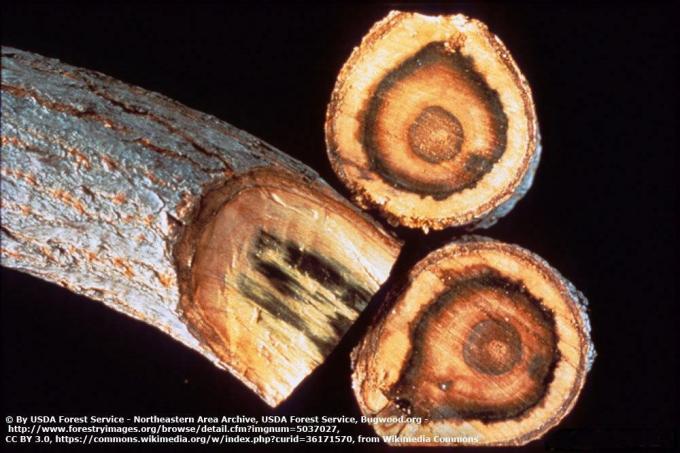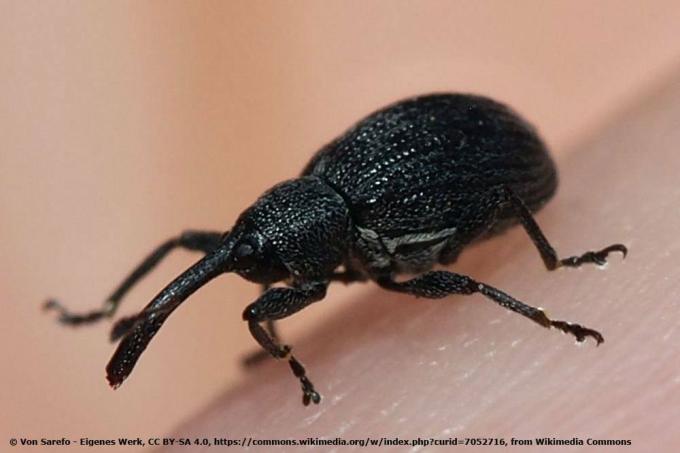
table of contents
- Pests & Diseases
- Strawberry powdery mildew
- Strawberry blossom cutter
- Leather rot
- Verticillium wilt
- Gnomonia fruit rot
- White and red spot disease
Strawberries are a must for every fruit fan and the red fruits are wonderful to grow in your own garden. However, a few maintenance measures must be observed, otherwise pests have an easy time of it. There are a handful of strawberry pests that are particularly fond of attacking the fruit. We present the most common pests and diseases below.
Pests & Diseases
The most common strawberry pests and diseases at a glance:
- Strawberry powdery mildew
- Strawberry blossom cutter
- Leather rot
- Verticillium wilt
- Gnomonia fruit rot
- White and red spot disease
Strawberry powdery mildew
Strawberry powdery mildew can occur on flowers and leaves as well as on the fruits themselves. Strawberries are particularly at risk if they are heavily weeded and have been in the bed for several years.
Powdery mildew can be recognized by the fact that a white coating forms on the underside of the leaf. The leaves turn purple and the top curls up. The rolling process usually only takes place after the harvest. If the fruits are affected, first the seeds and later the whole fruits are covered by the white coating. They don't get ripe and look like powdered sugar.
Symptoms
The symptoms of strawberry powdery mildew at a glance:
- whitish coating on the underside of the leaf
- powdered sugar-like pollination on seeds and strawberries
- rolled up leaf tips
Fight strawberry powdery mildew
To prevent infestation of the strawberries, you should not give nitrogen in the spring. It is also important that there is a 30 cm gap between two plants. During the flowering and ripening period, you should remove the weeds regularly. After the harvest is over, mow down the entire plant.
To treat the strawberries, you can use a fungicide use, the most suitable are products based on sulfur. When buying, make sure that the plant protection product is approved for use in allotment gardens.

Strawberry blossom cutter
The strawberry blossom cutter is a Beetlewhich leads to damage to the strawberries and ultimately to the death of the flower buds. As a result, the harvest is only possible to a very limited extent and a loss of yield sets in. You can recognize the infestation by the kinked flower buds. They snap off as the female of the beetle lays the eggs in the buds and gnaws the stem.
The strawberry blossom cutter belongs to the family of weevils. It is a black beetle with a pear-shaped head and an elongated body. Overall, the pest is around 2 - 3.5 mm in size. The eggs themselves are 0.5 mm long and have a white sheen.
Each female of these strawberry pests damages around 30 flowers because it lays just as many eggs. Filing takes place between April and June, if the weather is good, it can also take place earlier or later. If the strawberries are in a greenhouse, earlier egg laying is also conceivable.
Symptoms
The symptoms of the pests at a glance:
- kinked inflorescences in large numbers
- Signs of gnawing on the stem
- visible, whitish eggs in the buds
Combat strawberry blossom prick
If the strawberry population is small, you can manually look for the beetles before they bloom. Collect these from the plants. Through the Knock test you are the quickest to be successful. To do this, place a white cloth under the plant and tap it. Since the pest drops quickly, this is how you can expose it.
Once the infestation is recognized by symptoms, the only thing left to do is to prevent it from spreading. Gather any buds that have fallen off so they don't spread any further. After the harvest, a tansy infusion can help strengthen the plant.
Leather rot
This disease is not that common, but it does happen every now and then. Affected are unripe fruits that develop brownish-red spots. The fruit changes, feels like leather, and the consistency becomes rubbery.
If ripe fruits are affected, they develop purple spots. The pulp becomes soft, the taste of the fruit changes to bitter. Sometimes the leaf stalks are also affected, the leaves then wither and the plant fall apart.
Symptoms
The symptoms of the disease at a glance:
- brown-red spots on unripe fruits
- gummy consistency
- ripe fruits become soft and taste bitter
Treatment of leather rot
The leather rot caused by a fungus cannot be treated. The spores of the causative fungus are in the ground and from there get onto the fruit. Since they can survive there for several years, you should give up the strawberry bed and build a new bed with strawberries in a new place.
Verticillium wilt
Suddenly it wilts, the strawberry plant. At first it is only one specimen, then it appears in nests. The reason for this is the Verticillium wilt. Blotchy petioles, tendrils and inflorescences are the first signs of this. The disease usually only occurs after the ripening period, when the tendrils are already fully developed.
If the weather is warm and dry, the risk is particularly high. Usually the plants are affected in bundles and visually differ enormously from the healthy specimens.
Symptoms
The symptoms of the disease at a glance:
- Development of dark spots on the stems
- small, short-stemmed leaves are formed
- Plant appears dwarfed and small
Control of Verticillium wilt
It is hardly possible to treat this disease because the pathogens have numerous host plants. These include tomatoes, potatoes, alfalfa and many ornamental plants and woody plants. With a deep soil exchange, it is sometimes possible to get the pathogen out of a bed. All plants must be completely removed.
The soil removed and the plants are highly contagious and must be disposed of separately or, if possible, burned. Even with this measure, the disease cannot always be eradicated.

Gnomonia fruit rot
Gnomonia fruit rot is characterized by the fact that the fruit stalks and sepals have a brown discoloration after the flowering period. The fruit only develops poorly, green fruits turn brown, but not soft. When the fruits are ripe, they rot excessively quickly.
With this type of fruit rot, the fruits remain hard, they do not soften and gradually show dark spots. Due to this disease, the leaves initially appear withered, but then partially die off completely and the plant looks bare.
Symptoms
The symptoms of the disease at a glance:
- brown discoloration of the fruit stalks and sepals
- poor fruits that turn from green to brown
- no softening of the fruit
Treating gnomonia fruit rot
The cause of this fruit rot is a fungus that can overwinter on the petioles and fruit mummies of strawberries. The plant is infected with the pathogen long before flowering begins. The fungus is spread through rainfall. Treatment with non-chemical agents makes little sense because the fungus is very robust and resistant.
As a preventive measure, you should remove old leaves in the spring and not treat them with nitrogen. Make sure that there is sufficient space between the plants so that the foliage can dry off well. It is important that you always remove weeds. If fruits are infected, they must be disposed of immediately.
White and red spot disease
The white and red spot disease affects the foliage and causes a general weakening of the plant. The white spot disease occurs after the fruit has ripened, white spots develop on the leaves that merge into a brown edge. The foliage becomes dry and dies, the plant is weakened.
The red spot disease manifests itself similarly, it forms brown spots, but without the typical, white core. If the plant is heavily infested, the entire foliage turns reddish-brown.

Symptoms
The symptoms of the disease at a glance:
- brown spots on the leaves
- white spots in white spot disease
- weak appearance of the plant
Treatment of the disease
As a preventive measure, it is helpful to work straw under the plant. Heavy fertilization with nitrogen is harmful, the plant becomes more susceptible to the fungus. If the infestation is severe, you should completely remove the leaves. New shoots are then usually free from infestation.
Important: Burn the cut plant material or dispose of it with household waste. It must not be placed on the compost as the spores can spread.




